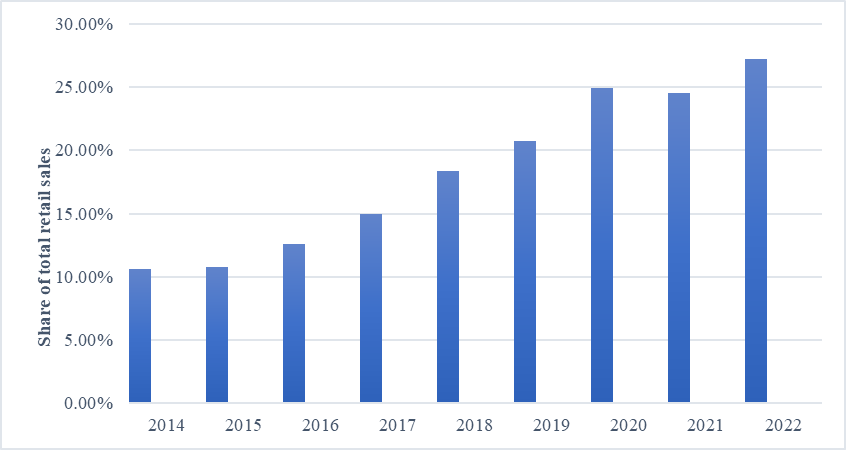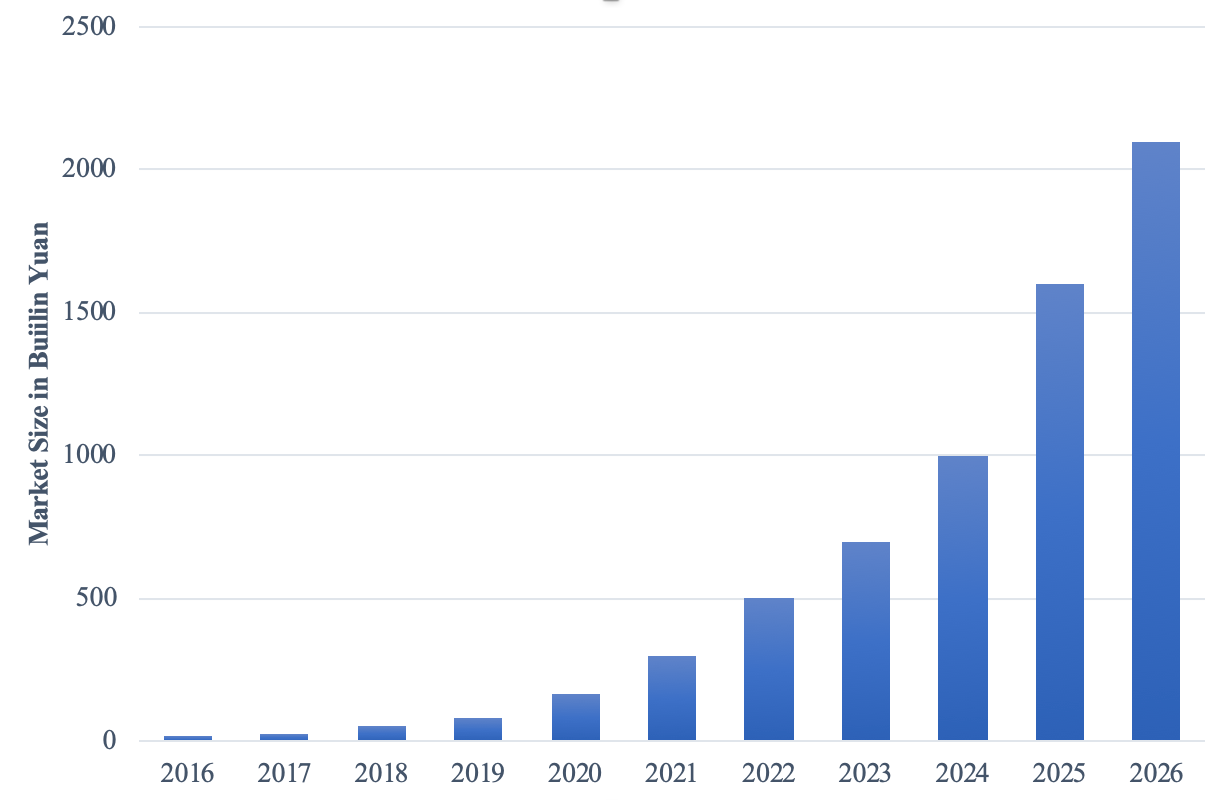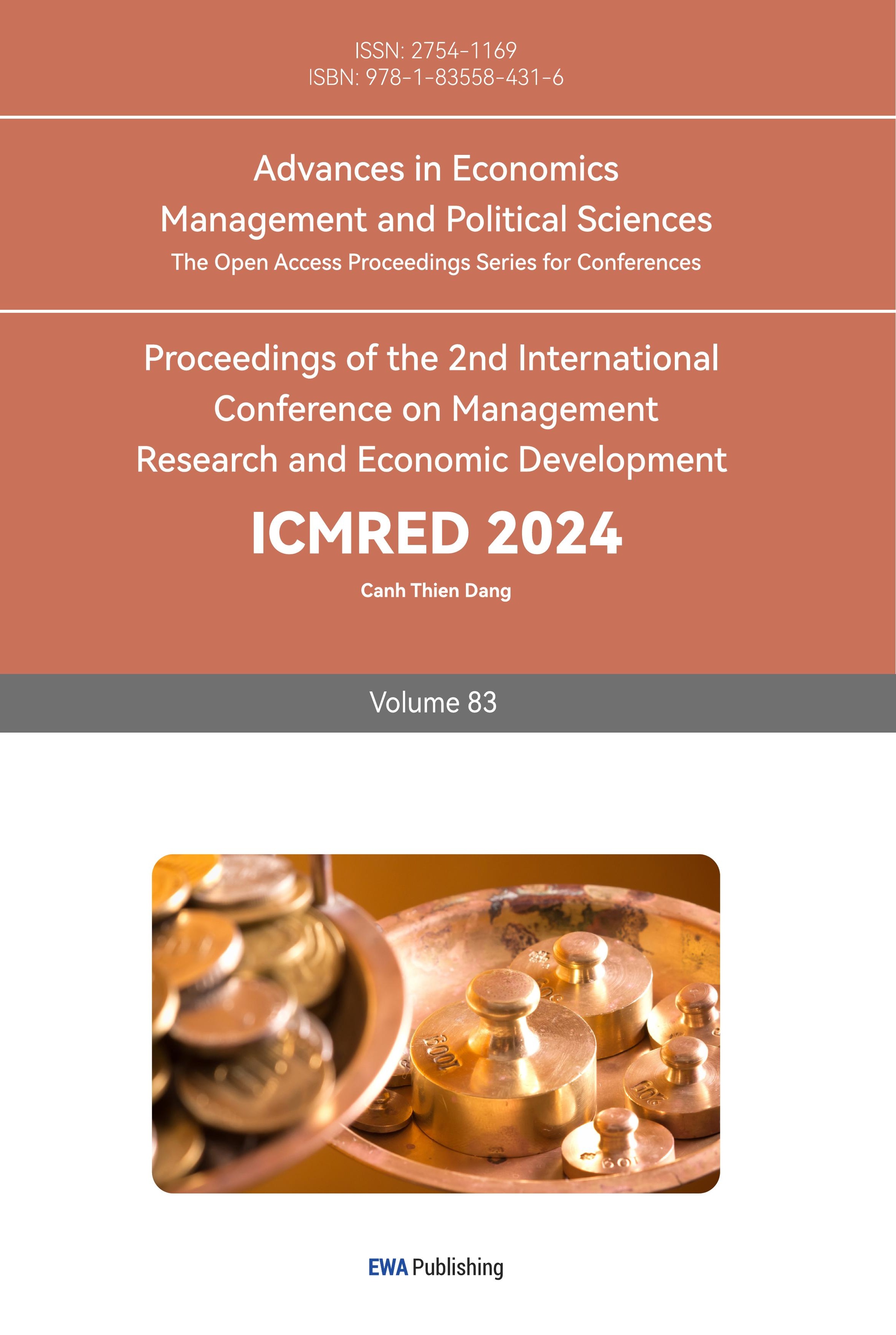1. Introduction
With the continuous development of China, intelligent development has been further popularized in all parts of China. Therefore, online shopping has developed and progressed with the support of the public, facilitating daily lives in all aspects. Shopping on mobile terminal is more flexible and convenient than offline consumption. People do not have to find spare time to go shopping in the mall, which greatly saves customers’ time and makes shopping easy to do anytime and anywhere.
The most popular online shopping platforms in China are Taobao, Tmall and TikTok. The development of these platforms is also very rapid. In 2008, Taobao launched in September for the first time with sales exceeding 10 billion. In 2009, it became China’s largest online marketplace. Similarly, the popularity of e-commerce has also allowed more merchants in remote areas to sell their goods to other cities, which has brought great convenience in agricultural products and purchasing.
The e-commerce platform wants to let more people know their products and quickly increase exposure on the internet. The easiest way is to use some stars and internet celebrities to endorse their products. Influencers and celebrities on the internet have millions of followers, so their videos and promotions will be more easily noticed by potential consumers. In this way, there will be more consumers to buy the advertised products. However, it also involves new problems. For example, some merchants would ask some online opinion leaders to give false publicity to their products, so that their products could have a lot of negative effects, which is a kind of deception for consumers. In this article, data and examples are used to analyze and discuss the problems existing in online shopping, and how to avoid and improve them.
This article first describes the rapid development of China’s e-commerce and the status quo of steady rise, and then discusses the problem of false publicity derived from the publicity methods of network broadcast, hoping to restrain the exaggerated publicity methods of network celebrities, so that consumers can have a real awareness of the quality and use of products, and protect the rights and interests of theirs.
2. E-Commerce and Livestream Commerce in China
China’s e-commerce development is booming, with high trading volumes and steady growth in the economy. China’s several major e-commerce platforms have also made huge achievements in just a few years.

Figure 1: Share of E-Commerce in total retail sales in China between 2014 and 2022 (Source of data: Statista).
As can be seen from Figure 1, the transaction volume of online shopping platforms is steadily increasing, from 10% in 2014 to 27% in 2022. China was also the world’s largest retail market in 2022. The development of e-commerce is now also trying to emphasise the two-way integration of online and offline, in order to provide more convenient and faster and a variety of goods and services, the real convenience and simplicity of shopping to consumers, as well as to better enhance consumer confidence.
The rapid development of China’s online trading platform covers many aspects, not only the continuous innovation in the country, but also the follow-up of overseas online trading and the government has also played a part [1, 2]. Government have created a favourable environment for the development of e-commerce, with regulations and policies to support it. Although China’s GDP figures are quite impressive, its per capita value and wealth level are still much lower than those of developed countries. In fact, the per capita GDP of many coastal cities has reached the level of newly industrialized countries, while the inland areas are much lower [3]. The development of online shopping has actually driven more inland areas to promote their products, so that they have more opportunities for domestic transactions and foreign trade activities [4, 5].
3. Analysis on Livestreaming in E-Commerce Marketplace
3.1. Current situation of Livestreaming
The form of selling goods through online publicity began to emerge from 2016 and 2017, when internet celebrities on the online platform began to promote products to their fans in the form of live broadcasting. Yet, this time is still in the early stage of attempt and development, and there are fewer network celebrities and merchants involved.
In 2018, with the rapid development of e-commerce and the rise of short video platforms, live broadcast publicity has been accepted and recognized by more merchants, so the way to promote products through online opinion leaders has gradually developed [6, 7].

Figure 2: Market size of livestreaming in China from 2016 to 2019 with forecasts until 2026 (Source of data: Statista).
According to Figure 2, from 2016 to 2019, China’s livestreaming market developed rapidly, and many merchants and anchors chose to join the ranks of livestreaming to promote and endorse products. The market size reaches to 84.34 billion yuan in 2019, from only 18.01 billion yuan in 2016. In 2019, due to uncontrollable reasons such as the epidemic, people could not go out for offline shopping, which brought an opportunity for the development of livestream shopping. The forecast in Figure 2 shows that the market size could rocket to as high as 2100 billion yuan in 2026. In the future, the online livestreaming market will continue to develop and drive China’s economy at a rapid growth rate.
3.2. Benefits from Livestream Commerce
Celebrities means to have a high popularity and attention, and there is a certain fan base. These fans can promote their products to bring high popularity and exposure. Therefore, the products promoted by stars also represent more opportunities for consumers to observe. On December 18, 2023, a 6.2-magnitude earthquake struck Gansu province in China, causing severe damage and killing 118 people. There are many little-known domestic brands that have made great contributions to earthquake relief. Some of them were close to bankruptcy, and some had not appeared in the eyes of the public for a long time. Later, some celebrities took the initiative to endorse these domestic brands, since their visibility on the internet can make more people pay attention to these companies, and their sales and visibility slowly rebounded.
Celebrity endorsements sometimes save some brands that are about to be delisted and bring new vitality to local national enterprises. For example, Heilan Home and Xtep are brands that everyone is familiar with and recognized because of star publicity. Popularity of these two brands is spread among consumers by celebrity publicity [8, 9]. David Ng, the first poster boy for Heilan House in 2003, is a Chinese-American actor. Its successful image matches the urban white-collar style desired by the brand, achieving a good publicity effect for Heilan Home. Xtep is China’s sports brand, who uses endorsement stars are William Chan, Fan Cheng-cheng and Dilraba and so on. They are all influential stars in China with a large number of fans, which will enhance brand awareness.
In fact, livestreaming with goods also takes advantage of consumer psychology and expands the embodiment of star effect. Many consumers will choose to search on the internet when they come into contact with a new product for the first time. If they find that this product has been recommended by a beauty blogger with a lot of fans, or if the business marks the same model of the star on the product interface, many people will blindly believe that this product really has good effects, so as to achieve the effect of increasing orders and profits [10].
3.3. False Propaganda and Impeded Competition
Now that online shopping is so well-developed, many manufacturers will choose the form of online live broadcast to promote their products and spend a very high price to invite stars or opinion leaders on the internet to put in a good word for their products. However, this will also lead to the emergence of a lot of false information.
Many brands spend money to invite stars who would only tell consumers the advantages of this product but not about the shortcomings, so many consumers find that the actual product and publicity are far apart after purchase. Many celebrities do not pay too much attention to the real quality of their products when they choose to endorse them. After all, they do not need to guarantee their products, but many consumers who trust stars and opinion leaders would lose a lot of money for nothing, and even more seriously. They may face the situation of eat unhealthy food or harm themselves.
In China, TikTok is a popular among various types consumers product with high popularity and is deeply trusted e-commerce platform. Moreover, TikTok and Taobao also have many live streamers and internet celebrities who undertake the work of live advertising goods, among which the more famous live streamers with goods in Taobao are Li Jiaqi and Wei Ya. Li Jiaqi has gained a high level of trust and a large number of fans in the beauty industry, which has also allowed him to generate extremely high profits for the brand he promotes.
The recent case of fake Hetian jade being sold in Li Jiaqi's studio is ongoing, with some consumers claiming that Hetian jade purchased from his studio showed to be a carbonate-tremolite jade necklace after being sent to the identification center, while the brand insists that there were no quality problems with their products. This also reflects the inconvenience of online shopping and virtual shopping. Customer cannot see the appearance and color of the product with their own eyes, so such events could actually emerge endlessly. Therefore, what both sides could do is to get together and negotiate to find an authoritative institution to test, or seek relevant law consultations to protect their rights and interests.
These head anchors on the platform may suppress other emerging anchors because of their ultra-high popularity and the number of fans, hindering the competition between brands and anchors, and forcing brands to only give themselves the lowest price.
4. Suggestions
After investigation, in fact, the government can reduce the problem of false propaganda by modifying the policy. For example, the artist and the brand they represent are bound as a community of interests, and if the artist helps the brand to carry out false publicity, the artist also needs to bear certain legal responsibilities and pay certain restraint compensation. The government can increase some regulatory channels to allow businesses to carry out regular inspection of genuine products protection, which can not only ensure that artists are not deceived by bad merchants, but also ensure that consumers’ rights and interests to buy genuine products are maximized.
Of course, it is also necessary to avoid the problem of people deliberately reporting on the products they represent because of prejudice against celebrity endorsers. The government should implement due management of the platform, improve product quality inspection services and after-sales complaints and communication channels, so that consumers’ complaints can be quickly resolved, and try to avoid accidental injury or wrong treatment of merchants and consumers.
Government could also use the way of network review to test the manufacturer’s licenses and other certificates to deal with the problem. This will make consumers trust more in online shopping, so that consumers dare to buy new products without worrying about whether there are quality problems or cannot be after-sales problems, which will promote the volume of orders and have an impact on the subsequent research and development of emerging technologies.
5. Conclusion
With the progress of science and technology and the development of the Internet and e-commerce in China is also steadily improving. As time goes by, more consumers now choose online platforms for goods they need, and the marketplaces provided are also much more than before. In the past, consumers may only be familiar with Taobao and Tmall, etc. Now, according to different needs, many small platforms have been added to serve specific consumer groups. Diversified sales channels and publicity methods bring more choices to consumers, and also ensure that consumers can compare and reference when choosing products. The management of e-commerce network platforms is also constantly improving, bringing more efficient refund process and after-sales protection to consumers, which also promotes economic development and plays a leading role in the mainland economy. Therefore, it can be said that e-commerce has become a new industry in China, driving the development of the economy.
China’s online trading platform has been continuously improved, and the volume of online trading has steadily increased in recent years, even taking into account the shock from the epidemic. Although there are still some problems in the transaction and the true degree of commodity promotion is imperfect, the development and acceleration of China’s GDP brought by online transactions cannot be underestimated. Further, with express delivery can be sent to all parts of the country, online shopping well promotes the development of the economy. If the later revision of policies and regulations can better solve the false propaganda and improve the after-sale services, e-commerce would be guaranteed with the quality which can expand to a larger territory, bringing huge economic value to China and the world.
References
[1]. Wong, X., Yen, D. C. and Fang, X. (2004) E‐commerce development in China and its implication for business. Asia Pacific Journal of Marketing and Logistics, 16(3), 68-83.
[2]. Tan, Z. A. and Ouyang, W. (2004) Diffusion and Impacts of the Internet and E-commerce in China. Former Departments, Centers, Institutes and Projects, 71.
[3]. Liu, X. and Walsh, J. (2019) Study on development strategies of fresh agricultural products e-commerce in China. International Business Research, 12(8), 61-70.
[4]. Martinsons, M. G. (2002) Electronic commerce in China: emerging success stories. Information & Management, 39(7), 571-579.
[5]. Geng, J. and Li, C. (2020) Empirical research on the spatial distribution and determinants of regional e-commerce in China: Evidence from Chinese provinces. Emerging Markets Finance and Trade, 56(13), 3117-3133.
[6]. Cheung, M. (2016) The e-commerce revolution: Ensuring trust and consumer rights in China. In Handbook of Cultural and Creative Industries in China. Edward Elgar Publishing, 412-430.
[7]. Yoon, C. (2009) The effects of national culture values on consumer acceptance of e-commerce: Online shoppers in China. Information & Management, 46(5), 294-301.
[8]. Chang, Y., Wong, S. F., Libaque-Saenz, C. F. and Lee, H. (2019) E-commerce sustainability: the case of Pinduoduo in China. Sustainability, 11(15), 4053.
[9]. Baek, Y. M. (2015) Current status of E-commerce market in China and implication. Journal of digital Convergence, 13(1), 111-124.
[10]. Wang, X. and Liu, L. (2015) Empirical research on the influence factors of e-commerce development in China. The Open Cybernetics & Systemics Journal, 9(1).
Cite this article
Pei,Y. (2024). The Benefits and Costs of Livestreaming in E-Commerce Development in China. Advances in Economics, Management and Political Sciences,83,148-153.
Data availability
The datasets used and/or analyzed during the current study will be available from the authors upon reasonable request.
Disclaimer/Publisher's Note
The statements, opinions and data contained in all publications are solely those of the individual author(s) and contributor(s) and not of EWA Publishing and/or the editor(s). EWA Publishing and/or the editor(s) disclaim responsibility for any injury to people or property resulting from any ideas, methods, instructions or products referred to in the content.
About volume
Volume title: Proceedings of the 2nd International Conference on Management Research and Economic Development
© 2024 by the author(s). Licensee EWA Publishing, Oxford, UK. This article is an open access article distributed under the terms and
conditions of the Creative Commons Attribution (CC BY) license. Authors who
publish this series agree to the following terms:
1. Authors retain copyright and grant the series right of first publication with the work simultaneously licensed under a Creative Commons
Attribution License that allows others to share the work with an acknowledgment of the work's authorship and initial publication in this
series.
2. Authors are able to enter into separate, additional contractual arrangements for the non-exclusive distribution of the series's published
version of the work (e.g., post it to an institutional repository or publish it in a book), with an acknowledgment of its initial
publication in this series.
3. Authors are permitted and encouraged to post their work online (e.g., in institutional repositories or on their website) prior to and
during the submission process, as it can lead to productive exchanges, as well as earlier and greater citation of published work (See
Open access policy for details).
References
[1]. Wong, X., Yen, D. C. and Fang, X. (2004) E‐commerce development in China and its implication for business. Asia Pacific Journal of Marketing and Logistics, 16(3), 68-83.
[2]. Tan, Z. A. and Ouyang, W. (2004) Diffusion and Impacts of the Internet and E-commerce in China. Former Departments, Centers, Institutes and Projects, 71.
[3]. Liu, X. and Walsh, J. (2019) Study on development strategies of fresh agricultural products e-commerce in China. International Business Research, 12(8), 61-70.
[4]. Martinsons, M. G. (2002) Electronic commerce in China: emerging success stories. Information & Management, 39(7), 571-579.
[5]. Geng, J. and Li, C. (2020) Empirical research on the spatial distribution and determinants of regional e-commerce in China: Evidence from Chinese provinces. Emerging Markets Finance and Trade, 56(13), 3117-3133.
[6]. Cheung, M. (2016) The e-commerce revolution: Ensuring trust and consumer rights in China. In Handbook of Cultural and Creative Industries in China. Edward Elgar Publishing, 412-430.
[7]. Yoon, C. (2009) The effects of national culture values on consumer acceptance of e-commerce: Online shoppers in China. Information & Management, 46(5), 294-301.
[8]. Chang, Y., Wong, S. F., Libaque-Saenz, C. F. and Lee, H. (2019) E-commerce sustainability: the case of Pinduoduo in China. Sustainability, 11(15), 4053.
[9]. Baek, Y. M. (2015) Current status of E-commerce market in China and implication. Journal of digital Convergence, 13(1), 111-124.
[10]. Wang, X. and Liu, L. (2015) Empirical research on the influence factors of e-commerce development in China. The Open Cybernetics & Systemics Journal, 9(1).









